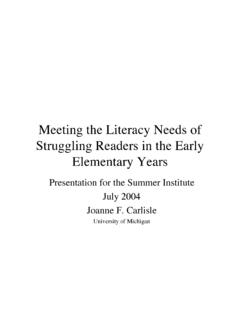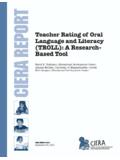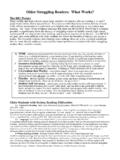Transcription of Building Comprehension in Struggling Readers - CIERA
1 Building Comprehension in Struggling Readers Teaching Every Child to Read Readiness Word Recognition Comprehension Assessment School Change Professional Learning Learning Disabilities Volunteers Second Language Learners Literacy Rich Text Environment Readiness Teachers: Engage children in extended conversations Encourage children to tell and retell stories and describe events Discuss a wide range of topics Ask open-ended questions Give explicit guidance on vocabulary, syntax, and pronunciation Encourage language play Challenge children to justify their thinking Focus on expressing ideas Susan Neuman Developing Word Recognition and Spelling Growth Stage Word Recognition Spelling Visual Cues Child recognizes words through Child spells with scribbles, distinctive features like the tail on pictures, or random letters.
2 Monkey Partial alphabetic use Child recognizes words by first or last Child spells words with first or letter. last letters or both, such as grl for girl. Full alphabetic use Child sounds out words using both Child uses vowels in spelling, vowels and consonants. although not always correctly, such as lat for late. Automaticity and advanced Child decodes most words Child learns about consonant concepts automatically, using phonograms and doubling, suffixes, and other analogies. complex aspects of spelling. Steve Stahl Assessing literacy skills and knowledge Grade Pre-K K 1 2 3. Letter identification; letter-sound X X X. correspondence Oral language and listening X X X. Concepts about print X X X. Phonological awareness X X.
3 Decoding and word recognition X X X X. Comprehension and retelling X XX X. Oral reading rate and fluency XX X. Attitudes about reading X X. Reading habits and interests X X. Scott Paris Comprehensive Literacy Oral Language speaking and listening Read Alouds Retellings Discussions Book Clubs/Literacy Circles Fluency word knowledge and vocabulary Automaticity Focus on constructing meaning Comprehension Reading Comprehension Instruction for Struggling Readers Directed questioning. Explaining concepts and procedures fully. Controlling difficulty of task demands. Modeling steps and processes. Providing cues to prompt children to use appropriate strategies. Having children work in small groups. Joanne Carlisle Shared Guided Independent Read Aloud Reading Reading Reading 100.
4 Teacher Responsibility Read Aloud 0. 0 Student Responsibility 100. reader Attributes Which Affect Comprehension Prior Knowledge and Experience Attitudes Toward the Purpose Interests in the Topic Self Perceptions as a Learner Small Group Instruction Ongoing assessment Guided instruction Responsive questioning Role of Comprehension As independence increases, it becomes even more important to provide students with instruction in Comprehension . Correlations between accuracy in reading words and Comprehension and/or recall of text decrease with passage difficulty. Comprehension comprises two skills: Word knowledge or vocabulary Reasoning Schemata Provides a framework for assimilating new information. Helps Readers focus their attention on what is important in the text.
5 Allows Readers to make inferences about information that is not explicit in the text. Allows for orderly searches of information stored in memory that are necessary to construct meaning. Makes it possible to summarize information by recognizing what is and is not important. Permits Readers to make inferences to help decide what kind of information might fill a memory gap. Anderson & Pearson 1984. Components of Comprehension Vocabulary Self-Monitoring Individual Strategies Routines (integrated set of strategies). Vocabulary occupies an important position in learning to read. For beginning Readers , reading vocabulary encountered in texts is mapped onto the oral vocabulary the learner brings to the task. Readers learn to translate unfamiliar words in print into speech, with the expectation that the speech forms will be easier to comprehend.
6 When a word is not in the learner's oral vocabulary, it will not be understood when it occurs in print. Results of Vocabulary Instruction Studying vocab results in gains in Comprehension . Vocab can be learned incidentally in when children are read to and when they read independently. Repeated exposure to vocab is important for learning gains. Pre-instruction of vocab words before reading facilitates vocab acquisition and Comprehension . National Panel Report, 2000t Word Pairs Same Opposite Go No Together Relation Desert/Nomad XXX. Nomad/Wanderer XXX. Nomad/Settler XXX. Desert/City XXX. Star/Energy XXX. Word Power: What Every Educator Needs to Know about Teaching Vocabulary, Stahl and Kapinus, 2001. Modified Frayer Model What is this?
7 Animal with Tough hide Examples Nonexamples pachyderm Elephant Horse Rhinoceros Elk Hippopotamus Ox What is it like? Thick-skinned Large hoofed Word Power: What Every Educator Needs to Know about Teaching Vocabulary, Stahl and Kapinus, 2001. Comprehension is best supported by: Careful discussion of stories students read on their own or are read to by the teacher Wide reading variety of texts, variety of genres, variety of topics, variety of purposes Explicit instruction in how to use strategies that help construct meaning P. David Pearson Accomplished Teachers' Approach to Comprehension Instruction Text-Based Higher Writing In Questions Level Response Questions To Reading Most Accomplished 48% 31% 48%. Teachers Somewhat 46% 8% 42%.
8 Accomplished Teachers Least 24% 0% 18%. Accomplished Teachers From Taylor et al, Beat the Odds Study Instructional Model Explicit description of the strategy and when it should be used Teacher and/or student modeling of the strategy in action Collaborative use of the strategy in action Guided practice using the strategy with gradual release of responsibility Independent use of the strategy Duke & Pearson The most important Comprehension strategies are: Summarizing texts (stories and descriptions). Finding the big ideas, themes Predicting events and outcomes Drawing inferences Linking new information to known information (prior knowledge). Graphic Organizers The main effect of graphic organizers is to the improve the reader 's memory for the content that has been read.
9 There are a variety of graphic organizers that can be used and they should be selected on the basis of their fit to the text being read and for the age level appropriateness for the reader . Typical Graphic Organizers include: Story maps Concept maps Mind maps Cause/Effects maps Character Trait maps Plot maps Reciprocal Teaching Multiple Strategy Instruction Summarization Question generation Clarification Prediction Organization Structured dialogue Small groups Teacher takes turns with students assuming the role of dialogue leader Taking turns, each student reads a paragraph and asks a clarifying question, asks a checking for understanding question, summarizes, and predicts. Palincsar, David, & Brown 1989. Example of Reciprocal Teaching Following script is from: Using Reciprocal Teaching in the Classroom: A Guide for Teachers A.
10 Palincsar, Y. David, & A. Brown, 1989. The pipefish change their color and movements to blend with their surroundings. For example, pipefish that live among green plants change their color to a shade of green to match the plants. Clare: [Question] One question that I had about this paragraph is: What is special about the way that the pipefish looks? Keith: Do you mean the way that it is green? Andy: It's not just that it's green; it's that it's the same color as the plants around it, all around it. Clare: [Summary] Yes. That's it. My summary is this part tells how the pipefish looks and that it looks like what is around it. [Prediction] My prediction is that this is about its enemies and how it protects itself and who the enemies are.









